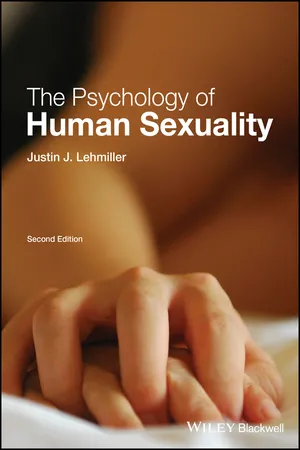
- English
- ePUB (mobile friendly)
- Available on iOS & Android
The Psychology of Human Sexuality
About this book
New edition of an authoritative guide to human sexual behavior from a biopsychosocial perspective
The thoroughly revised and updated second edition of The Psychology of Human Sexuality explores the roles that biology, psychology, and the social and cultural context play in shaping human sexual behavior. The author – a noted authority on the topic and an affiliate of the acclaimed Kinsey Institute - puts the spotlight on the most recent research and theory on human sexuality, with an emphasis on psychology.
The text presents the major theoretical perspectives on human sexuality, and details the vast diversity of sexual attitudes and behaviors that exist in the modern world. The author also reviews the history of sexology and explores its unique methods and ethical considerations. Overall, this important and comprehensive text provides readers with a better understanding of, and appreciation for, the science of sex and the amazing complexity of human sexuality.
- Features broad coverage of topics including anatomy, gender and sexual orientation, sexual behaviors, sexual difficulties and solutions, prostitution, and pornography
- Offers more in-depth treatment of relationships than comparable texts, with separate chapters dealing with attraction and relationship processes
- Includes cutting-edge research on the origins of sexual orientation and gender identity, as well as new treatments for sexually transmitted infections and sexual dysfunctions
- Is written from a sex-positive perspective, with expanded coverage of cross-cultural research throughout and material that is inclusive and respectful of a diverse audience
- Includes numerous activities to facilitate dynamic, interactive classroom environments
Written for students of human sexuality and anyone interested in the topic, The Psychology of Human Sexuality offers a guide to the psychology of human sexual behavior that is at once inclusive, thorough, and authoritative in its approach.
Frequently asked questions
- Essential is ideal for learners and professionals who enjoy exploring a wide range of subjects. Access the Essential Library with 800,000+ trusted titles and best-sellers across business, personal growth, and the humanities. Includes unlimited reading time and Standard Read Aloud voice.
- Complete: Perfect for advanced learners and researchers needing full, unrestricted access. Unlock 1.4M+ books across hundreds of subjects, including academic and specialized titles. The Complete Plan also includes advanced features like Premium Read Aloud and Research Assistant.
Please note we cannot support devices running on iOS 13 and Android 7 or earlier. Learn more about using the app.
Information
1
Theoretical Perspectives on Human Sexuality

CHAPTER OUTLINE
- Introduction
- What Drives Us to Have Sex?
- Psychological Influences
- Cultural and Societal Influences
- Biological and Evolutionary Influences
- Major Theoretical Perspectives on Human Sexuality
- Psychoanalytic Theory
- Cognitive-Behavioral and Learning Theories
- Exchange Theories
- Personality Theories
- Evolutionary Theory
- The Perspective of This Text
Introduction
What Drives Us to Have Sex?
Psychological Influences
Cultural and Societal Influences
Table of contents
- Cover
- Title Page
- Table of Contents
- About the Author
- Foreplay
- List of Illustrations
- List of Text Boxes
- List of Tables
- About the Companion Website
- 1 Theoretical Perspectives on Human Sexuality
- 2 Sexology Research: History, Methods, and Ethics
- 3 Human Sexual Anatomy
- 4 Human Sexual Response: Understanding Arousal and Orgasm
- 5 Gender and Gender Identity
- 6 Sexual Orientation
- 7 The Laws of Attraction
- 8 Intimate Relationships: Sex, Love, and Commitment
- 9 Sexual Behaviors
- 10 Lifespan Sexual Development
- 11 Sex Education, Contraception, and Pregnancy
- 12 Sexually Transmitted Infections and Safer‐Sex Practices
- 13 Sexual Dysfunction and Sex Therapy
- 14 Variations in Sexual Behavior
- 15 Sex Laws, Sexual Victimization, and the Sexual Marketplace
- Epilogue
- Glossary
- Index
- End User License Agreement